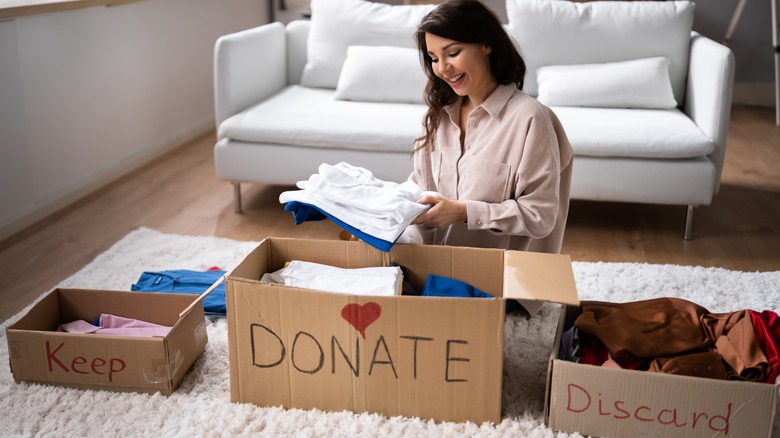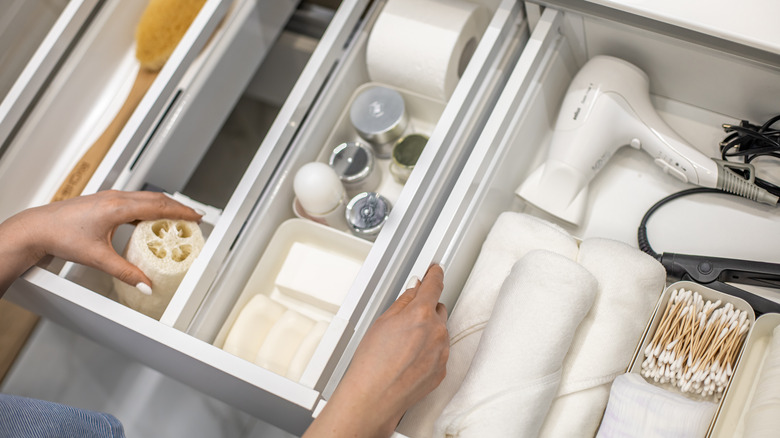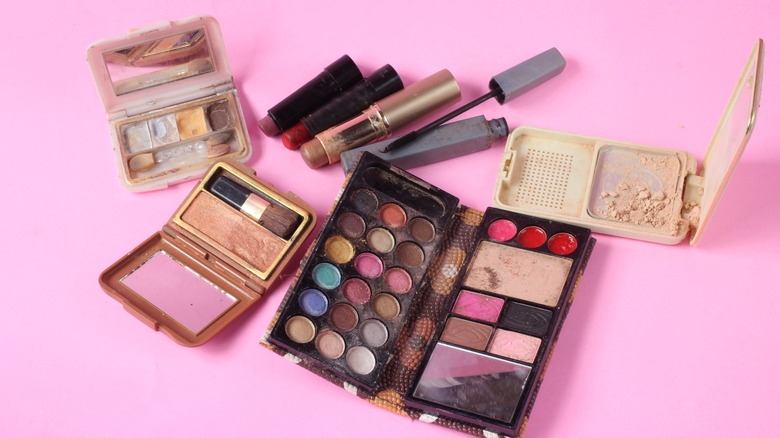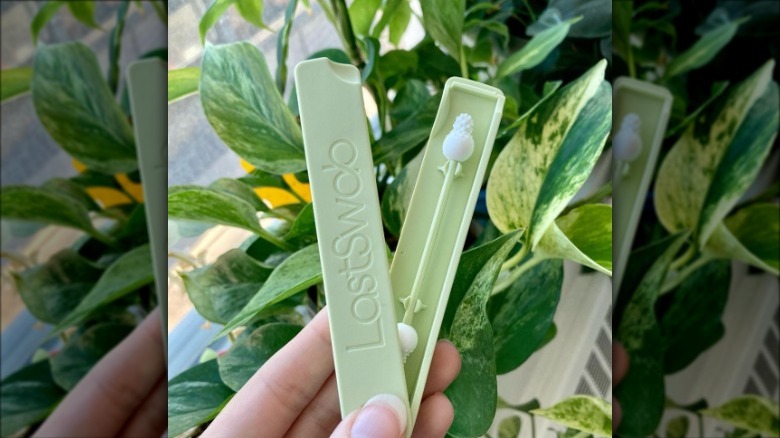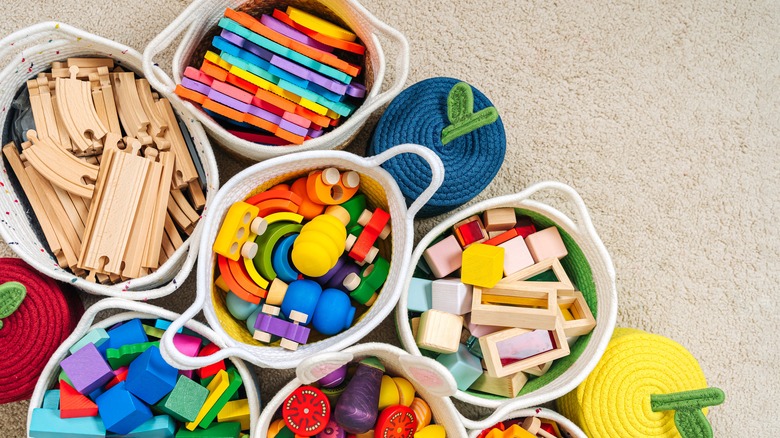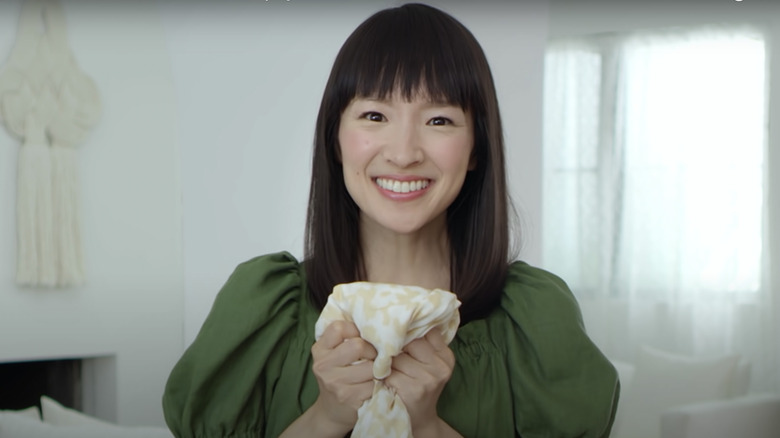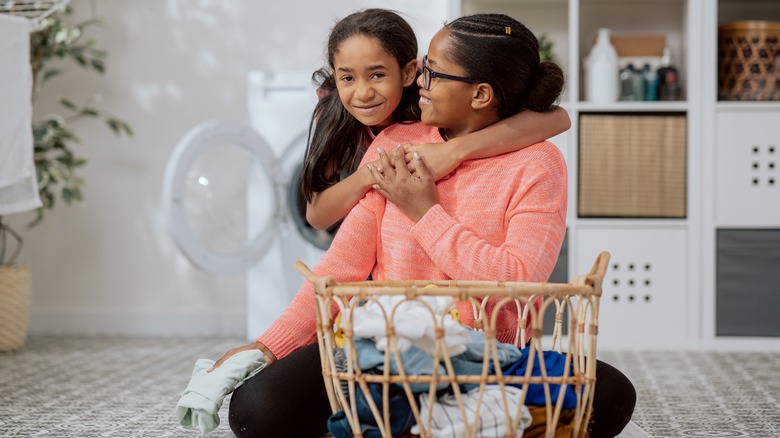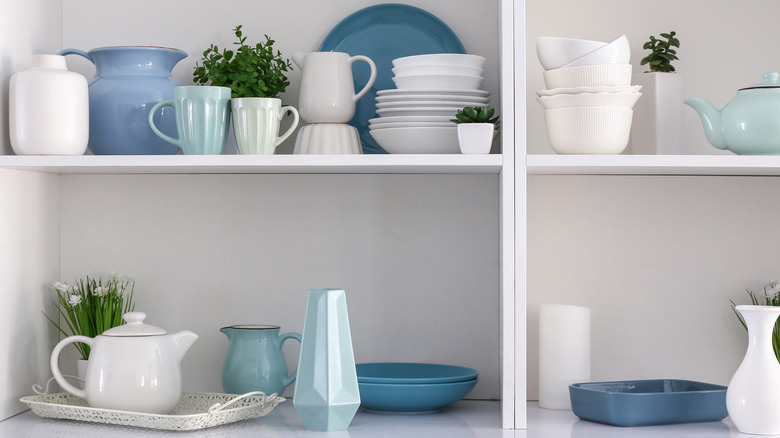Clever Little Ideas For Decluttering Your Space In 2023
We may receive a commission on purchases made from links.
We're all guilty of some form of hoarding, whether that means holding on to a shoe collection or a quirky assortment of coffee mugs. Clutter isn't necessarily a bad thing. Maximalist interiors have recently gained traction in mainstream design spaces. As Keren Richter, co-owner of White Arrow, a New York-based interior design studio, explains to Vogue, "Maximalism is the art of more-is-more; layered patterning, highly saturated colors, ample accessories and art (likely hung "salon-style"), and a real sense of playfulness and bold gestures."
Ultimately, maximalism is about more than just "stuff," it's about surrounding ourselves with things that bring us happiness — that could mean anything from cheetah print wallpaper to cute thrift store bowls. However, there comes a point when items weigh us down more than they boost our well-being. When gone unchecked, clutter can lead to increased stress and insomnia, according to Women's Health. It can even get in the way of relationships and lead to unhealthy eating habits. In the new year, build a happier home for yourself by clearing out things you no longer have a use for.
Ease into the process
TikTok creator @neat.caroline suggests starting small. As she notes, "small steps will lead to big changes over time." Concentrate on confined areas like overcrowded cutlery drawers, the linen closet, or your impressive collection of shoes. Alternatively, begin with the cleanest room and work your way up in intensity. Medium quotes computer scientist Paul Graham: "The way to do really big things seems to be to start with deceptively small things." That applies whether you're decluttering your house or building a multimillion-dollar business.
Part with doubles
If it's been a while since your last move, chances are you've accumulated several copies of the same item. For instance, TikTok creator @chicpeachaf shows off her impressive accumulation of mugs and cutting boards. As you ring the new year, it's a great time to sort through your cabinets, keeping the items you regularly use and discarding doubles.
If you're surprised by the sheer number of spatulas or can openers in your kitchen, you're not alone. "We always have way more stuff than we even imagine," professional organizer Maija Diethelm tells Pods Blog.
Declutter from the ground up
Professional organizer Kayleen Kelly, who posts as @kayleenkellyorganize on TikTok, has a tip: Declutter from the ground up. Though it might involve more than a little squatting, picking up items off the floor will make an immediate difference. Clean Mama recommends setting a timer for anywhere between 10 and 30 minutes, using that period to move dirty clothes to the hamper (and next to the laundry machine), pick up trash, and return out-of-place items to their rightful bins. Because storing items on the ground makes any space feel more crowded, Apartment Therapy suggests wall-mounted shelving.
Make a game out of it
If you're someone who likes creative forms of motivation, all you need is a small basket, a pencil, and paper. TikTok creator @theblondebibee demonstrates the method, writing numbers 1 through 30 on small slips before folding them up and putting them in a receptacle. She also writes numbers 1 through 20, repeating the process three times. Every day, draw a number and challenge yourself to get rid of that many items, whether that means recycling old magazines or donating picture books that your children no longer read.
Sort items by category
Interior designer and TikTok creator Gilla Leigh (@gillaleighhome.designs) recommends using labeled bins to organize your items into four categories: donate, sell, keep, and trash. Find a place near you that accept drop-off donations. Some services even offer free at-home pick-up, per Moving.com. Alternatively, sell your unwanted clothes on platforms like Asos Marketplace, Poshmark, or Etsy. Remember to do your research before posting items online. If you plan to sell clothes onThredUP, for instance, there's a less than 50% chance that they'll make it to the virtual resale shelves.
Throw away expired food and makeup
We're all familiar with expiration dates printed onto milk bottles and grocery store deli sandwiches, but skincare products, makeup, and over-the-counter medications expire too. Schedule a day to go through your pantry, refrigerator, and bathroom cabinets. Just as eating food well beyond its best-by date can have health consequences, using expired makeup can result in bumps, itchiness, and even conditions like pink eye, per Ohio State Health & Discovery. According to Mayo Clinic, liquid makeup products like eyeliner and mascara can be kept for up to three months, while powdered products are usable for a maximum of two years.
Schedule a try-on day
Host a mini fashion show in your home. All you need is yourself, a mirror, and a little patience. For instance, TikTok creator @alegeiz tries on her pants collection, deciding which pairs to give away and which to keep. Depending on the number of items cramping up your closet, take it one category at a time: shorts, tops, shoes, etc. Katie Gassmann (@katiegassmann) tries on her long dress collection, while @moremollyplease sorts through sleeveless tops exclusively.
Cut back on disposable products
Professional organizer and content creator @neat.caroline notes that cutting back on disposable products like plastic bags, Q-Tips, and loofahs can save on storage space. Rather than purchasing items in boxy packaging, opt for reusable alternatives. For instance, this LastObject "cotton" swab has a life expectancy of over 1000 uses. Dry brushes, as suggested by @neat.caroline, are the ideal loofah replacement. They're unrivaled exfoliants and they don't need to be thrown out every couple of months, per Cleveland Clinic. Switching to a zero-waste beauty routine is not only good for the environment, but it'll also help you tackle some of that clutter.
Try out the hanger hack
The so-called "hanger hack" can be used to distinguish between items you regularly wear and those you don't. Interior design expert @everydaygracedesigns advises flipping your hangers in the "wrong" direction with the tip pointing out. Once you wear something — your go-to turtleneck, a favorite pair of jeans — hang it back up and turn the hanger around the "right" way. Over just a few months, you'll have a visual of which items are worth keeping and which are no longer necessary. If you're looking for a quicker solution, simply wait until laundry day and take a look at all the items that went untouched that week.
Have you heard of the ex test?
Apartment Therapy is an advocate for the so-called "ex test," asking yourself, "If I left this item at an ex's house, would it be worth going back for?" If the answer is no, it's probably time to officially break up with that book, sweater, or pair of sunglasses. In that vein, if you're still storing memorabilia from past relationships, send off those little boxes of memories to the donation pile. Not only will this clear up some much-needed closet space, but it might also be an important step in the moving on process.
When you buy something new, get rid of something old
When it comes to decluttering, take the "out with the old, in with the new" motto very seriously — paying special attention to the "out with old" part, of course. TikToker @chicpeachaf explains the "one box in, one box out rule," the idea that bringing a new box of items into the house should be accompanied by sending another out. The bottom line? Consider what you already have before buying new things. Otherwise, you might end up with an untamed collection of throw pillows or an outdated assortment of graphic tees.
Organizing is not the same thing as decluttering
Intimidated by the process? Keep in mind that decluttering a space is not the same as organizing it. Your primary goal is to clear out unwanted items, not rearrange them in Container Store bins.YouTuber Ronald L. Banks says that organizational systems often act as a "band-aid." In other words, tucked-away drawers might make clutter less visible, but they do nothing to solve the original problem of having too much stuff. Marie Condo, author of "The Life-Changing Magic of Tidying Up: The Japanese Art of Decluttering and Organizing," agrees. In her words, "Storage experts are hoarders. Putting things away creates the illusion that the clutter problem has been solved."
Would you buy it in a store today?
When sorting through your things, ask yourself this simple question: If I saw this in a store today, would I buy it? If the answer is no, it's probably time to part ways. NBC Better by Today recommends other easy prompts for clearing out your closet. Ask yourself whether an item still fits or if you feel comfortable in it. Why keep that uncomfortable pair of skinny jeans or heels that are just a few inches too high? Psychology professor Jennifer Pfeuffer, Psy.D., explains the connection between our wardrobes and mental health to Verywell Mind. In her words, "If we're able to see ourselves in a way that creates a positive emotion, perhaps we will engage less in negative thinking about ourselves and feel less need to compare ourselves to others." Ultimately, keep items that make you feel confident and discarded the rest.
If you can digitize, do it
There are only so many stained recipe print-outs, crayon drawings, and years-old report cards that we can hold onto. When it comes to clutter, sentimentality is often our downfall. Fortunately, scanning old drawings, documents, and photographs allows us to hold on to memories while still banishing them from our physical space. As the creator @kimsterrrs demonstrates on TikTok, you can get just as creative with digital scrapbooks as you can with paper.
Higher Information Group notes that digitized documents are preferable for businesses, too. They're easier to access, more efficient, and ultimately more secure. This year, ditch those filing cabinets and store information on your laptop instead.
Clean out your cleaning supplies
Though it may seem contradictory to their intended purpose, cleaning supplies are one of the main categories of clutter. Rather than storing dozens of different, chemical-packed products under the sink, opt for the essentials: baking soda, white vinegar, ammonia, and dish soap. Along with these items, The Muse also recommends Mr. Clean Magic Erasers. Not only are at-home solutions effective and space-saving, but they're also cheaper than specialty products. Professional organizer @neat.caroline shows off six different purposes for vinegar including using it as a glass cleaner, wood cleaner, and laundry booster.
Ask yourself why you want to declutter
Before you begin the decluttering process, write down your motivations. According to psychologist Lorna Mograby, the urge to throw away can turn into a compulsion for some. "Clutter can cause extreme anxiety to the point that they need to get rid of it right away," she explains to Metro.co.uk. "The perfectionist mentality would mean that the person has such high expectations as to the standard of tidiness of their environment that [sic] they take decluttering to an extreme level — often getting rid of useful items they may require later or even throwing away gifts." Decluttering isn't the same thing as committing to minimalism. "As we live in a society that advocates minimalism and criticizes [sic] consumerism, an individual might feel guilt at the amount of possessions they have," says Mograby. The bottom line? Hold on to things you love.
Marie Kondo is famous for asking this important question
The sixth and final step in Marie Kondo's tidying process is asking yourself one central question: "Does this spark joy?" (via KonMari). If an item makes you feel good inside, it's worth keeping even if it's not a necessity.
"Hold each item in your hands, as close to your heart as possible," advises the professional organizer, per The Guardian. "When something sparks joy, you should feel a little thrill running through your body, as if your body is somehow slowly rising up to meet the item, embracing it even."
Try out the tape challenge for your cluttered kitchen drawers
All you need for this hack is a roll of tape, ideally of the Washi or painter's variety. TikTok creator @declutter.your.life explains the method, starting with putting Washi tape on the items in your kitchen drawer. Every time you use an item, peel it off. Over the span of just a few weeks, you'll be able to distinguish between items that get regular use and those that just aren't worth keeping. Kitchn suggests giving yourself up to a year for items you use exclusively during the holidays, such as cookie cutters or pie pans.
Involve your kids and the decluttering process
No matter how tempting, it's important never to throw away someone else's possessions. When it comes to your kid's rooms, toys, and school supplies, involve them in the decluttering process. According to the American Academy of Child & Adolescent Psychiatry, it's helpful to involve your children in household chores as young as two or three years old. Author Ali Wenzke shares another piece of advice with Better by Today. "Before my kids and I declutter toys and books, we choose a charity where our donations will go," she says. "It makes it real when you know who will receive your item."
Invest in organizational tools after you've finished decluttering
There's no sense in organizing items you're just going to get rid of anyway. Apartment Therapy suggests waiting to invest in storage tools until after you're done decluttering. According to architect and interior designer Julia Arco, "Open shelves provide vertical storage, which helps to maximize limited space," per Family Handyman. She also notes that this type of storage discourages clutter because everything is on full display. The same goes for glass medicine cabinets in the bathroom — just make sure you're up for the challenge of maintaining a clean, organized display.
